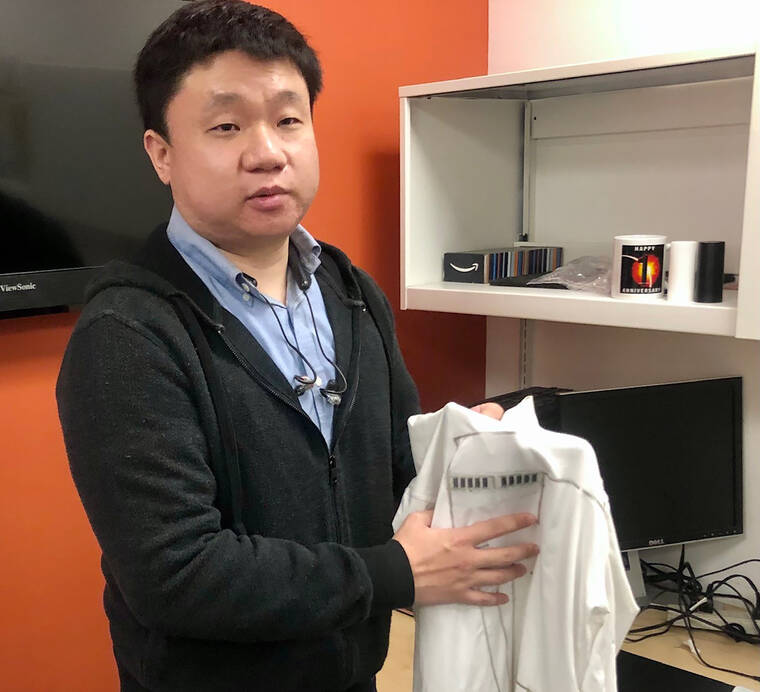Will this T-shirt one day power your cellphone? UCSD researchers think so

Yu Lin, a UC San Diego Ph. D. student at the Jacobs School of Engineering, holds what researches have dubbed a “wearable microgrid” that can harvest and store energy while the wearer moves or exercises. (Rob Nikolewski/San Diego Union-Tribune/TNS)
Call it the electric T-shirt. Or, as the researchers at the University of California San Diego have dubbed it, the “wearable microgrid.”
Call it the electric T-shirt. Or, as the researchers at the University of California San Diego have dubbed it, the “wearable microgrid.”
Whatever its nickname, the long-sleeve shirt designed by the brainiacs at the Jacobs School of Engineering can harvest and store energy while the wearer is moving or exercising. The school’s nanoengineers anticipate that someday the prototype will be refined to the point where electronic devices like cellphones won’t have to rely on the electric grid for power but can run on the articles of clothing people wear every day.
And, perhaps, generate power that’s literally at the tips of our fingers.
“What we want to achieve in the end is to have a system where you don’t need to think about charging anymore,” said Lu Yin, a nanoengineering Ph.D. student who has worked closely with Joseph Wang, director of the Center for Wearable Sensors at UC San Diego.
The shirt collects, or harvests, energy from the human body that can be stored and then used to power small electronics, such as an LCD wristwatch.
Biofuel cells that are powered by the sweat produced by the wearer are located inside the shirt at the chest. On the shirt’s forearms and torso, triboelectric generators harvest energy as the user walks or jogs. At the same time, supercapacitors placed on the shirt’s chest temporarily store the energy and then discharge it to power devices.
It sounds like the prototype would be bulky and awkward to wear but it’s lightweight, flexible and not affected by bending, folding or crumpling. The shirt can be washed in water, as long as no detergent is used.
The energy generated by the swinging of the user’s arms while running or walking works on the same principle as static electricity.
“It’s very energy efficient and very suitable for these low-energy, low-power applications,” Yin said, adding that the shirt’s design is unique in terms of its functionalities.
The idea for the shirt was inspired by microgrids that have the ability to run independent of the electric grid.
Portable and wearable electronics, such as smartwatches, have grown in popularity. Combined with the near-universal adoption of personal computers, iPhones and other devices, there’s a concerted effort to find alternative energy sources to run them all.
Self-powered technology envisions devices that can operate on their own, without relying on an external energy supply. Such a transition would reduce the need for the countless number of batteries that currently power our gadgets, not to mention the impact such an adaptation would have on potentially reducing energy demand on an increasingly strained electric system.
“I think mainly the (research and development) still lies on how to perfect the energy harvesting part,” Yin said. “What we demonstrated is energy harvesting up to a few hundred microwatts. We want that to be increased, maybe tenfold, and we’re getting there.”
The key will be scaling up the technology. The UC San Diego shirt is not yet powerful enough to run, say, a cellphone.
But Yin sees the shirt as a way to provide “smart sensing” to monitor things such as the wearer’s heart rate and oxygen levels. “We are also working on wearable blood pressure monitoring,” he said.
Private companies in the activewear sector have expressed interest in the UC San Diego research. Yin sees another practical application for the shirt — generating luminescence for joggers who run at night.
“We are very optimistic about the whole trend of wearable electronics, especially the integration of these energy storage devices with energy harvesters,” Yin said. “We see a roadmap for future development.”
In related research, UC San Diego engineers have developed a thin, flexible strip that can be wrapped around the fingertip like a Band-Aid. The wearable device can generate small amounts of electricity when a person’s finger sweats, or when the finger is pressed.
Touted as the first of its kind, the device is about 1 centimeter square, or less than half an inch. A padding of carbon foam electrodes absorbs sweat and converts it into electrical energy.
You wouldn’t think that your finger perspires very much but “what we figured out is that on the fingertip, the sweat rate is much higher compared to other parts of the body,” Yin said. “That’s why we have so many grooves on the finger because it contains hundreds of sweat glands along each groove.”
Electrodes equipped with enzymes trigger chemical reactions between lactate and oxygen molecules in sweat to generate electricity. As the wearer sweats on the strip, electrical energy gets stored in a small capacitor and can be discharged to devices when needed.
“The level of power we’re generating is in terms of best case, maybe hundreds of microwatts per finger,” Yin said. “It’s still some distance away from powering a cellphone.”
The UC San Diego researchers had a subject wear the device on one fingertip while performing sedentary activities. After 10 hours of sleep, the device collected almost 400 millijoules of energy — enough to power an electronic wristwatch for 24 hours. One hour of typing and clicking on a mouse saw the device collect almost 30 millijoules.
Though the fingertip device and the “electric T-shirt” represent two different studies, UC San Diego nanoengineers think of their wearables research as an integrated effort.
“We are definitely moving towards the next generation of electronics,” Yin said. “We envision it to be more flexible, more conformable to the human body, to be more durable and eventually self-sustainable. That’s the eventual goal we want to get to.”


